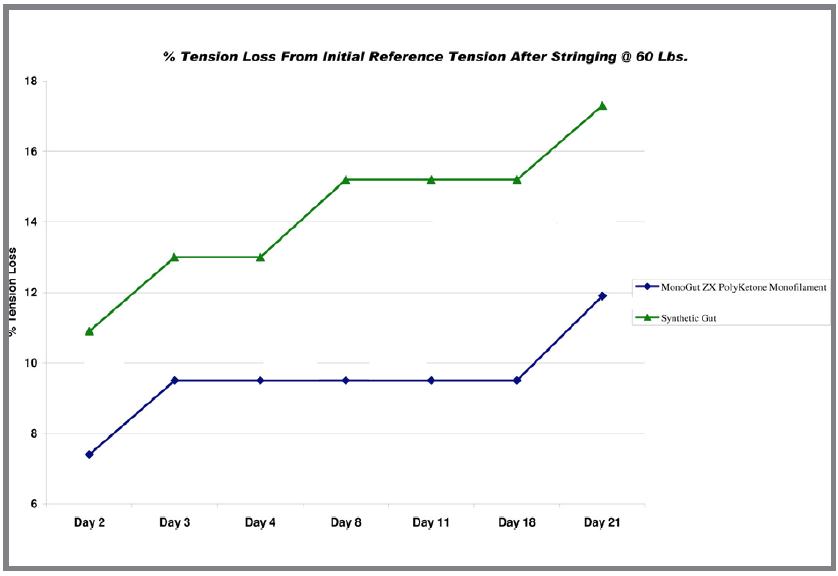By Steve Crandall, Vice President, Sales & Marketing, Ashaway Racket Strings
We’ve used the terms “dynamic stiffness” and “tension loss” any number of times in this column but have never really explained what we mean, in a technical sense. That’s because many people’s eyes glaze over at the mere mention of the word “technical,” and the appearance of a chart or graph induces an automatic page-flip reaction. Nevertheless, these terms are very important in understanding why various string materials behave as they do, and how those behaviors can affect your game.
So we’re going to take the plunge here and delve into the arcana of string technology. We’ll try to keep our discussion tethered to the reality of play by talking in terms of two well-known string materials, natural gut and multifilament nylon, and comparing them to the latest high tech material to hit the squash courts, Zyex®. For the technically squeamish among you, just think of the chart as abstract art.
Natural gut is seldom used by squash players these days, but in my youth (when squash racquets were still made of wood), it was the gold standard. What made gut the superstar of its era was its ability to stretch on impact and then rebound quickly without deformation or loss of tension. This is because gut absorbs the force of impact, not the racquet or the player’s arm. In other words, it plays “soft.” Gut also returns that force to the ball very quickly and efficiently, providing more power. And, because it stretches, it allows the ball more dwell time on the strings, so players can “pocket” the ball to enhance control. Finally, gut maintains tension over the life of the string, enhancing its value. Gut was also quite durable when struck on the sweet spot, though not so much on off-center frame hits, especially in the thinner gauges (17 and 18) used for squash strings. This made it better for better players, but very expensive for us average Joes.
Enter multifilament nylon, which has taken over as the gold standard for squash. Nylon strings are very inexpensive compared to gut. They are quite responsive, and provide good abrasion resistance. But multifilament nylon’s main drawback is that it loses tension more quickly than other string materials. This means it doesn’t last as long in your racquet, so you have to buy more of it.
Multifilament nylon’s other weakness is that, while it was for years the “most gut-like alternative to gut,” it really doesn’t compare that well to gut’s elasticity—its ability to stretch and rebound so quickly. That’s what dynamic stiffness is all about. In the lab, dynamic stiffness is expressed in pounds per inch, and in laymen’s terms, it is a measure of how much a string stretches when it strikes the ball. The more stretch, the more power it returns to the ball and the less impact it has on your arm and elbow. The less it stretches, the more energy is lost in flattening the ball and the less total power is available for rebound.
As in golf, the lower the dynamic stiffness ‘score,’ the better. For today’s leading natural gut tennis string, this number comes in around 108 lb./in, according to the US Racquet Stringers Association (USRSA). Multifilament nylon is also respectably low, ranging between 160 and 200 lb./in, but it pales in comparison to Zyex-based strings, which range between 145 and 150 lb./in. In fact, the dynamic stiffness of Zyex is the closest to gut of any synthetic string material ever made.
As for tension loss (here comes the chart!), USRSA Certified Master Racquet Technician and veteran stringer John Gugel recently ran some tests, the results of which he has graciously allowed us to present. Although the tests were run on tennis string, the results are representative.
John took a number of strings, including nylon multifilament (i.e., Synthetic Gut) and Ashaway’s 100% Zyex monofilament MonoGut® ZX, and strung them at 60 lbs. on identical racquets using the same stringing machine. He then stored the strung racquets under stable temperature and moisture conditions, and measured the string tension every day for twenty-one days.
As you can see, both strings lost tension in the first couple days after stringing as they “settled” into the frames. The Synthetic Gut lost about 13% during this period, while the Zyex string lost 9.5%. After that, the Synthetic Gut continued to lose tension fairly steadily, with a couple plateaus of stability in between. The Zyex lost the least tension, and held it steady the longest. Overall, Synthetic Gut lost the most tension at 17.3%, while the Zyex lost least at 11.9%. To put that another way, nylon lost over 45% more tension than the Zyex.
In sum, because of its dynamic stiffness, Zyex-based string absorbs and returns impact force more like gut than nylon or any other synthetic material. It controls the ball more like gut, especially in thinner gauge strings, and holds tension as well, or perhaps even a bit better than gut, and much better than nylon. Perhaps that’s why folks have been calling Zyex the “space age nylon.”






